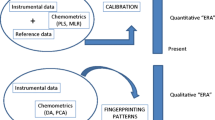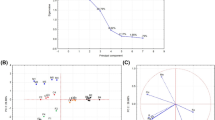Abstract
The application of qualitative analytical techniques is usually associated with the analysis of data sets targeting issues related with the presence or absence of a particular class or type of sample, pattern recognition and cluster analysis. In food sciences, these techniques are generally used to deal with the authenticity, classification, discrimination, fraud and origin of foods. In recent years, qualitative analysis became more relevant in both food research and industry applications, addressing fraud and traceability concerns in the food value chain. In this overview, some of the most common classification methods and techniques used in food sciences will be briefly described, with emphasis on the validation, interpretation and reporting of the results obtained.

Similar content being viewed by others
References
Adams, M.J. (1995) Chemometrics in analytical spectroscopy. In: NW Barnett (eds) RSC Spectroscopy Monographs. The Royal Society of Chemistry. UK, p 216
Badertscher M, Pretsch E (2006) Bad results from good data. Trends Anal Chem 25:1131–1138
Beebe KR, Peel RJ, Seasholtz MB (1998) Chemometrics a practical guide. John Wiley & Sons Ltd, New York, USA
Berrueta LA, Alonso-Salces RM, Herberger K (2007) Supervised pattern recognition in food analysis. J Chromatogr A 1158:196–214
Bevilacqua M, Necatelli R, Bucci R, Magri AD, Magri SL, Marini F (2014) Chemometric classification techniques as tool for solving problems in analytical chemistry. J AOAC Int 97:19–27
Brereton RG (2000) Introduction to multivariate calibration in analytical chemistry. Analyst 125:2125–2154
Brereton RG (2006) Consequences of sample size, variable selection, and model validation and optimization, for predicting classification ability from analytical data. Trends Anal Chem 25:1103–1111
Brereton RG (2008) Applied chemometrics for scientist. John Wiley & Sons Ltd, Chichester, UK
Brereton RG (2009) Chemometrics for pattern recognition. John Wiley & Sons Ltd, Chichester, UK
Brereton RG (2015) Pattern recognition in chemometrics. Chemom Intell Lab Syst 149(2015):90–96
Bro, R., & Smilde, A.K (2014). Principal component analysis: a tutorial review. Anal Methods, 6, 2812–2831.
Cozzolino D (2012) Recent trends on the use of infrared spectroscopy to trace and authenticate natural and agricultural food products. Appl Spectrosc Rev 47:518–530
Cozzolino D (2014) An overview of the use of infrared spectroscopy and chemometrics in authenticity and traceability of cereals. Food Res Int 60:262–265
Cozzolino D, Cynkar WU, Dambergs RG, Shah N, Smith P (2009) Multivariate methods in grape and wine analysis. International Journal of Wine Research 1:123–130
Ellison SLR, Fearn T (2005) Characterising the performance of qualitative analytical methods: statistics and terminology. Trends Anal Chem 24:468–476
Engel J, Gerretzen J, Szymanska E, Jansen JJ, Downey G, Blanchet L, Buydens LMC (2013) Breaking with trends in pre-processing. Trends Anal Chem 50:96–106
Esbensen KH (2002) Multivariate data analysis in practice. CAMO Process AS, Oslo, Norway
Esslinger S, Riedl J, Fauhl-Hassek C (2014) Potential and limitations of non-targeted fingerprinting for authentication of food in official control. Food Res Int 60:189–20
Gishen M, Dambergs RG, Cozzolino D (2005) Grape and wine analysis—enhancing the power of spectroscopy with chemometrics. A review of some applications in the Australian wine industry. Aust J Grape Wine Res 11:296–305
Gonzalez GA (2007) Use and misuse of supervised pattern recognition methods for interpreting compositional data. J Chromatogr A 1158:215–225
Granato D, Calado VMA, Jarvis B (2014) Observations on the use of statistical methods in food science and technology. Food Res Int 55:137–159
Hawkins DM (2004) The problem of overfitting. Journal of Chemical Informatics Computational. Science 44:1–12
Khakimov B, Bak S, Engelsen SB (2014) High-throughput cereal metabolomics: current analytical technologies, challenges and perspective. J Cereal Sci 59:393–418
Khakimov B, Gürdeniz G, Engelsen SB (2015) Trends in the application of chemometrics to foodomics studies. Acta Aliment 44:4–31
Kumar N, Bansal A, Sarma GS, Rawal RK (2014) Chemometrics tools used in analytical chemistry: an overview. Talanta 123:186–199
Moller SF, von Frese J, Bro R (2005) Robust methods for multivariate data analysis. J Chemom 19:549–563
Naes T, Isaksson T, Fearn T, Davies T (2002) A user-friendly guide to multivariate calibration and classification. NIR Publications, Chichester, UK, 420 p
Otto, M. (1999) Chemometrics: statistics and computer application in analytical chemistry. Wiley-VCH, 314
Pulido A, Ruisanchez I, Boque R, Rius FX (2003) Uncertainty of results in routine quality analysis. Trends Anal Chem 22:647–654
Skov T, Honore AH, Jensen HM, Naes T, Engelsen SB (2014) Chemometriocs in foodomics: handling data structures from multiple analytical platforms. Trends Anal Chem 60:71–79
Smyth H, Cozzolino D (2013) Instrumental methods (spectroscopy, electronic nose and tongue) as tools to predict taste and aroma in beverages: advantages and limitations. Chem Rev 113:1429–1440
Szymanska E, Gerretzen J, Engel J, Geurts B, Blanchet L, Buydens LMC (2015) Chemometrics and qualitative analysis have a vibrant relationship. Trends Anal Chem 69:34–51
Westad F, Marini F (2015) Validation of chemometric models: a tutorial. Anal Chim Acta 893:14–23
Acknowledgments
The support of Central Queensland University is acknowledged.
Author information
Authors and Affiliations
Corresponding author
Ethics declarations
Conflict of Interest
Mr. Neville Doyle declares that he has no conflict of interest. Dr. Dave Swain declares that he has no conflict of interest. Dr. J.J. Roberts declares that he has no conflict of interest. Daniel Cozzolino declares that he has no conflict of interest.
Ethical Approval
This article does not contain any studies with human or animal subjects.
Informed Consent
(In case humans are involved) Informed consent was obtained from all individual participants included in the study.
(If not applicable on the study) Not applicable.
Rights and permissions
About this article
Cite this article
Doyle, N., Swain, D., Roberts, J.J. et al. The Use of Qualitative Analysis in Food Research and Technology: Considerations and Reflections from an Applied Point of View. Food Anal. Methods 10, 964–969 (2017). https://doi.org/10.1007/s12161-016-0654-8
Received:
Accepted:
Published:
Issue Date:
DOI: https://doi.org/10.1007/s12161-016-0654-8




